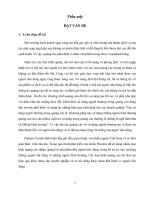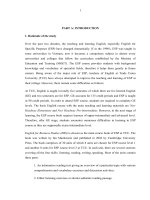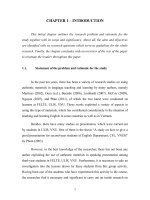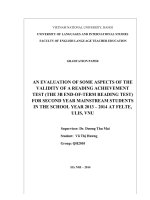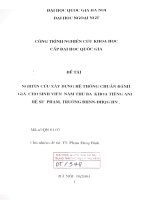hững khó khăn về ngôn ngữ và sư phạm trong việc dạy từ vựng tiếng Anh chuyên ngành cho sinh viên năm thứ ba chuyên ngành điện tử Trường đại học Công nghiệp thàn.PDF
Bạn đang xem bản rút gọn của tài liệu. Xem và tải ngay bản đầy đủ của tài liệu tại đây (730.46 KB, 19 trang )
VIET NAM NATIONAL UNIVERSITY, HANOI
UNIVERSITY OF LANGUAGES AND INTERNATIONAL STUDIES
FACULTY OF POST-GRADUATE STUDIES
****************************************
HOÀNG THỊ HẢI ĐƯỜNG
TEACHERS’ LINGUISTIC AND PEDAGOGICAL
CHALLENGES IN TEACHING ESP VOCABULARY TO
THE THIRD – YEAR STUDENTS OF ELECTRONICS
ENGINEERING AT HO CHI MINH UNIVERSITY OF
INDUSTRY BASED IN THANH HOA
(NHỮNG KHĨ KHĂN VỀ NGƠN NGỮ VÀ SƯ PHẠM TRONG VIỆC DẠY TỪ VỰNG
TIẾNG ANH CHUYÊN NGÀNH CHO SINH VIÊN NĂM THỨ BA CHUYÊN NGÀNH ĐIỆN
TỬ TRƯỜNG ĐẠI HỌC CÔNG NGHIỆP THÀNH PHỐ HỒ CHÍ MINH CƠ SỞ
THANH HĨA)
MINOR M.A THESIS
Field: English Teaching Methodology
Code: 60 14 10
HÀ NỘI, 2011
VIET NAM NATIONAL UNIVERSITY, HANOI
UNIVERSITY OF LANGUAGES AND INTERNATIONAL STUDIES
FACULTY OF POST-GRADUATE STUDIES
****************************************
HOÀNG THỊ HẢI ĐƯỜNG
TEACHERS’ LINGUISTIC AND PEDAGOGICAL
CHALLENGES IN TEACHING ESP VOCABULARY TO
THE THIRD – YEAR STUDENTS OF ELECTRONICS
ENGINEERING AT HO CHI MINH UNIVERSITY OF
INDUSTRY BASED IN THANH HOA
(NHỮNG KHĨ KHĂN VỀ NGƠN NGỮ VÀ SƯ PHẠM TRONG VIỆC DẠY TỪ VỰNG
TIẾNG ANH CHUYÊN NGÀNH CHO SINH VIÊN NĂM THỨ BA CHUYÊN NGÀNH ĐIỆN
TỬ TRƯỜNG ĐẠI HỌC CÔNG NGHIỆP THÀNH PHỐ HỒ CHÍ MINH CƠ SỞ
THANH HĨA)
MINOR M.A THESIS
Field: English Teaching Methodology
Code: 60 14 10
Supervisor: VŨ MAI TRANG, M.A
HÀ NỘI, 2011
iv
TABLE OF CONTENTS
Candidate’s statement ……………………………………………………………………i
Acknowledgements ……………………………………………………………………….ii
Abstract ………………………………………………………………………………..…iii
Table of contents …………………………………………………………………………iv
List of abbreviations …………………………………………………………………….vii
List of tables ……………………………………………………………………………viii
CHAPTER 1: INTRODUCTION ……………………………………………………....1
1.1Rationale……………………………………………………………………………….1
1.2 Aims of the study ……………………………………………………………………..1
1.3. Research questions …………………………………………………………………...2
1.4. Scope of the study ……………………………………………………………………2
1.5. Methods of the study …………………………………………………………………3
1.6.Design of the study …………………………………………………………………...3
CHAPTER 2: LITERATURE REVIEW ……………………………………………...4
2.1. An overview of ESP ………………………………………………………………….4
2.1.1. The Concepts of ESP…………………………………………………………..4
2.2.1. Classification of ESP…………………………………………………………..4
2.2. Teaching ESP vocabulary…………………………………………………………….4
2.2. 1. What is ESP and EEE vocabulary……………………………………………...5
2.2.1.1. What is ESP vocabulary………………………………………………… 5
2.2.1.2. What is EEE vocabulary…………………………………………………5
2.2.2. Important aspects of ESP vocabulary teaching………………………………...5
v
2.2.2.1. Word formation ………………………………………………………….5
2.2.2.2. Word - form ……………………………………………………………..6
2.2.2.3. Grammar…………………………………………………………………6
2.2.2.4. Aspects of meaning………………………………………………………6
2.2.2.5. Pronunciation and spelling……………………………………………….7
2.3. Terminology…………………………………………………………………………..8
2.3.1. Definition of terminology………………………………………………………8
2.3.2. Characteristics of terminology……………………………………………….....8
2. 4. Methodology in vocabulary teaching………………………………………………...9
2.4.1. The grammar- translation method……………………………………………....9
2.4.2. Direct Method…………………………………………………………………10
2.4.3. The communicative approach (CLT)………………………………………… 10
2.4.4. Audio-lingual method…………………………………………………………11
2.5. ESP teaching vocabulary challenges for teachers…………………………………..11
2.5.1 The roles of ESP teachers……………………………………………………..11
2.5.2. Teachers’ linguistic challenges in ESP vocabulary……………………….....13
2.5.3. Teachers’ pedagogical challenges in teaching ESP Vocabulary…………....14
2.6. Summary…………………………………………………………………………… 15
CHAPTER 3: RESEARCH METHODOLOGY……………………………………16
3.1. The context of teaching and learning vocabulary at Ho Chi Minh university of
industry…………………………………………………………………………………..16
3.1.1. Brief introduction of Ho Chi Minh City University of industry based in Thanh
Hoa………………………………………………………………………………… …16
3.1.2. The teachers and teaching methods…………………………………………....16
3.1.3. The students and their background …………………………………………... 17
3.2. The course book……………………………………………………………………..18
3.2.1. The textbook…………………………………………………………………... 18
vi
3.2.2 Book content…………………………………………………………………….18
3.3. Methods and procedures …………………………………………………………....19
3.3.1. Research questions ……………………………………………………………...19
3.3.2. The participants …………………………………………………………………19
3.3.3. Data collection instruments ……………………………………………………..19
3.3.4. Data collection procedure ………………………………………………………20
3.3.5. Data analysis ……………………………………………………………………21
3.4. Findings and discussion ............................................................................................21
3.4.1. The teachers’ questionnaire …………………………………………………….21
3.4.1.1. The teachers’ linguistic challenges in teaching EEE vocabulary ……...21
3.4.1.2. The teachers’ pedagogical challenges in teaching EEE vocabulary ….23
3.4.1.3. The teachers’ personal view of sources of their challenges in teaching
EEE vocabulary …………………………...........................................................24
3.4.1.4 The teachers’ suggestions to improve their EEE vocabulary teaching……….26
3.4.2. Findings from the interviews and journal writings…………………………………....27
3.4.2.1. The teachers’ linguistic challenges in teaching EEE vocabulary ……27
3.4.2.2. The teachers’ pedagogical challenges in teaching EEE vocabulary...30
3.4.2.3. The teachers’ suggestions to improve their EEE vocabulary teaching..31
CHAPTER 4: SOLUTIONS………………………………………………………….33
4.1. Ways of training EFL Teachers for ESP teaching………………………………......33
4.2. Improving teachers’ professional knowledge……………………………………….34
4.3. Improving teacher’s activities in teaching vocabulary…………………………… 34
4.3.1. Sample activity 1: Guess the meaning…………………………………….….35
4.3.2. Sample activity 2: .Brainstorming……………………………………………35
vii
4.3.3. Sample activity 3: Group-work .………………………………………..……..35
4.4. Teaching word formation……………………………………………………………37
CHAPTER 5: CONCLUSIONS……………………………………………………….39
5. 1. Summary of the study………………………………………………………………39
5. 2. Limitations and suggestions for further studies ……………………………………40
REFERENCES ……………………………………………………………………….... 41
APPENDICES …………………………………………………………………………....I
APPENDIX 1 ……………………………………………………………………………..I
APPENDIX 2 …………………………………………………………………………....IV
APPENDIX 3……………………………………………………………………………VI
1
TEACHERS’ LINGUISTIC AND PEDAGOGICAL CHALLENGES IN TEACHING
ESP VOCABULARY TO THE THIRD – YEAR STUDENTS OF ELECTRONICS
ENGINEERING AT HO CHI MINH UNIVERSITY OF INDUSTRY BASED IN
THANH HOA
Chapter1: Introduction
1.1 Rationale
Nowadays, the English language has been widely used in many areas such as politics,
economics, tourism, telecommunication, culture, science, technology, so on. Since Vietnam carried
out the open door policy towards the regional and global integration, the English language has
become more and more important for people of all ages and careers nationwide. Therefore, there is
great demand for teaching and learning English throughout the country for different purposes.
In teaching English for Specific Purposes, however, no one argues that the scope of specialized
vocabulary is a primary goal. Up to now, teaching ESP, particularly teaching vocabulary, has still
been far from satisfaction. With many similar characteristics and a number of different features in
comparison with General English, ESP is viewed as something hard to teach for language teachers.
In the context of Ho Chi Minh University of Industry ( HUI ) based in Thanh Hoa province,
students are taught English as a compulsory subject. In addition, students of Electronic
Engineering have to learn English for electronics at the beginning of the third academic year. In
fact, with a short duration of 30 periods, one of the most important aims of ESP course for these
students is achieving basic ESP vocabulary. However, in reality, the teacher researcher has seen
students have troubled during their English learning process. In the first place, most of the students
said that they had to deal with a wider range of unfamiliar words and cope with their growing
specialized vocabulary. Consequently, it is hard for them to study with their limited knowledge of
vocabulary. They often learn vocabulary passively through their teachers‟ explanation. There are
also too many new words given in each lesson, too little time spent on memorizing and recycling
those words.
As a teacher of English for Electronics Engineering (EEE), the teacher herself finds out many
difficulties during teaching vocabulary. At first, in her opinion, the difficulties probably arise from
the lack of specialized knowledge, which makes teachers fail to provide every reasonable
explanation. Moreover, the target students at HUI based in Thanh Hoa province are at lower levels
2
in comparison with those at colleges or universities on the ground of needs, interest and
motivation. In addition, it is difficult for teachers to understand a lot of terminology, complicated
structures and countless expressions.
Facing this problem, the teacher researcher of English of HUI made an attempt to do
something to change the ways of teaching and learning vocabulary in order to improve the
students' learning effectiveness to help them succeed in their future job. In this study, therefore, the
teacher researcher has conducted a research namely: “Teachers’ linguistic and pedagogical
challenges in teaching ESP vocabulary to the third-year students of Electronics Engineering
at Ho Chi Minh University of Industry based in Thanh Hoa province”.
1.2.Aims of the study
The study aimed at:
- Giving a brief overview about ESP, vocabulary and its relevance in teaching English for
Electronics Engineering at HUI.
- Finding out Teachers‟ linguistic and pedagogical challenges that ESP teachers at HUI are
facing in teaching English vocabulary to students of Electronics Engineering.
- Suggesting some solutions to the teaching of vocabulary to students of Electronics
Engineering effectively.
1.3. Research questions
The research is carried out with an attempt to find out the answer to the following research
questions:
- What are the main teachers‟ linguistic and pedagogical challenges experienced by teachers
who are teaching ESP vocabulary to students of Electronics Engineering at HUI?
- What solutions should be offered to help teachers to find out the effective ways to teach ESP
vocabulary to students of Electronics Engineering at HUI?
1.4. Scope of the study
Dealing with all types of teaching ESP vocabulary is too large for studying this size. Thus, this
study focuses on investigating linguistic and pedagogy challenges that the teacher encounters in
teaching ESP vocabulary to students of the third-year students of Electronics Engineering at Ho
Chi Minh University of Industry based in Thanh Hoa province.
Therefore, proper teaching methods can be adopted to help them overcome the difficulties.
The solutions are also provided to help to improve teaching and learning English in general,
teaching and learning English Electronic vocabulary in particular at HUI.
1.5. Methods of the study
3
In order to achieve the aims mentioned above, the study was designed to use varieties of
methods including interview, questionnaire and teaching journal analysis. The data were recorded
both formally and informally. The survey questionnaire to teachers is to get more information to
support the study.
1.6. Design of the study
The thesis consists of five chapters, with a list of references, and appendices
Chapter I: “Introduction”, presents the rationale, objectives, research questions, scope as well
as methods of the study.
Chapter II: “Literature review”, deals with the theoretical background for the study.
The
focus of this chapter is vocabulary and ESP vocabulary, some important aspects of ESP vocabulary
teaching, some techniques currently used in teaching vocabulary and ESP vocabulary.
Chapter III: “Methodology”, is the main part of the study. It gives a brief introduction on the
context of teaching ESP vocabulary at HUI, the data collection methods and procedures. In
addition, the data will be analyzed and the findings will reveal the difficulties in teaching ESP
vocabulary to the third-year students at HUI. Some suggestions to improve the teaching of ESP
vocabulary will be given in this chapter.
Chapter IV: „Solution”, deals with ways to improving the teaching ESP vocabulary at HUI.
Chapter V: “Conclusions”, summarizes the findings, refers to some limitations of the study,
and offers suggestions for further studies.
CHAPTER 2: LITERATURE REVIEW
2.1. An overview of ESP and English of Electronics Engineering
2.1.1. The Concepts of ESP
2.1.2. Classification of ESP
2.2. Teaching ESP vocabulary
2.2.1 What is ESP and EEE vocabulary
2.2.1.1. What is ESP vocabulary
2.2.1.2. What is EEE vocabulary
2.2.2. Important aspects of ESP vocabulary teaching
2.2.2.1. Word formation
4
2.2.2.2. Word - form
2.2.2.3. Grammar
2.2.2.4. Aspects of meaning
2.2.2.5. Pronunciation and spelling
2.3. Terminology
2.3.1. Definition of terminology
2.3.2. Characteristics of terminology
2.4. Methodology in vocabulary teaching
2.4.1. The Grammar- translation method
2.4.2. The Direct Method
2.4.3. The Audio-lingual method
2.4.4. The Communicative approach (CLT)
2.5. Teachers’ linguistic and pedagogical challenges in teaching ESP vocabulary
2.5.1 The roles of ESP teachers
2.5.2. Teachers’ linguistic challenges in ESP vocabulary
2.5.3. Teachers’ pedagogical challenges in teaching ESP vocabulary
2.6. Summary
CHAPTER 3: METHODOLOGY
3.1. The context of teaching and learning vocabulary at Ho Chi Minh University of
Industry
3.1.1. Brief introduction of Ho Chi Minh City University of Industry based in Thanh Hoa
Province
3.1.2. Teachers and teaching methods
3.1.3. Students and their background
3.2. The course book
3.2.1. The textbook
After finishing the course of General English, the students are taught English for Specific
Purpose. Students of Electronics learn the book “English for Electronics” which was written by
Eric H. Glendinning &John Mc “English for Electronics” aims to provide students with basic
knowledge and skill to work in electronic environment.
5
Actually, this book consists of 30 units, designed in harmonious combination with EEE topics
to enable students to develop both their language skills in EEE world, from low to higher. Clearly,
each unit is divided into five parts, and each part lays a focus on grammar, function or vocabulary.
As a result, in each unit, students have more opportunities to learn and develop their knowledge in
categories of grammar, vocabulary, communication skill, and pronunciation through practice
activities of, reading, writing, and speaking.
3.2.2. Book content
The whole course for the third year EE students consists of 6 units from unit 1 to unit 6 in the
first semester. The syllabus consists of 30 periods (45 minutes per period) and is delivered within 6
weeks covering 6 topics as follows: Unit 1: Electronics in the home -Unit 2: Component valuesUnit 3: Making a recording - Unit 4: Remote control-Unit 5: Alarm systems -Unit 6: Radio.
The following unit structure is used throughout the book with some variation among 9 units:
1
Tuning-in : introducing the topic through picture description or fact discussion
2
Language study: revise structures and grammatical points necessary for students to deal
with electronic documents in English .i.e. Actions in sequence, If sentences, Reduced time
clauses
3
Word study: developing students ‟knowledge of electronic terms, vocabulary use and
word form, i.e. Prefixes, Word pairs, Transitive verbs.
4
Technical reading: providing practice through various kinds of tasks as well as
expanding students‟ vocabulary repertoire, i.e. Understanding diagrams, Resistor values,
Capacitor values, Diode codes.
5 Writing: Provide practice in writing skills, i.e. Describing diagrams, a process, a system
It is very effective to work with this book as it provides students with a great deal of technical
terms and develops their reading comprehension and writing electronic documents. However, the
teachers and students have found it difficult in teaching this course book because of the following
reasons.
First, as each unit has five periods the students usually do not have enough time to practice in
class. Second, the vocabulary teaching integrated with other skills meaning that no separate
vocabulary lesson is provided. Consequently, the teacher have to decide themselves how to teach
vocabulary, when and how much to teach as well. Next, there are a lot of difficult abbreviations
and too many difficult and long terms in a task e.g. R(1K)/ a one kilohm resistor: C (5-65PF)/a
five-to-sixty-five-picofarad capacitor,
tolerance and 2,4 V zener voltage.
BZX55C2V4./ a silicon zener diode which has 5%
6
3.3. Methods and procedures
3.3.1. Research questions
The research is carried out with an attempt to find out the answers to the following questions:
- What are the main teachers‟ linguistic and pedagogical challenges experienced by teachers
who are teaching ESP vocabulary to students of Electronics Engineering at HUI?
- What solutions should be offered to help teachers to find out the effective ways to teach ESP
vocabulary to students of Electronics Engineering at HUI?
3.3.2. The participants
This study was conducted with the participation of 10 English teachers and 3 EEE teachers‟
writing journals. These 10 teachers of English at the college are chosen for the investigation as all
of them have been teaching ESP. They are 6 females and 4 males and have at least 2 years‟
experience in teaching ESP.
3.3.3. Data collection instruments
In order to collect the most exact information for the study, the three types of instruments were
employed as follows:
Questionnaire
Interview
Journal writing
4.3.4. Data collection procedure
In order to collect the data for the analysis, the questionnaire was delivered to each teacher
individually to ensure that they would give their own ideas without being affected by their
colleagues. After the teachers had finished their questionnaire, they were interviewed for further
information in the questionnaire.
After each lesson, three teachers were invited to write journals to reflect what happened in
class. These teachers were asked to give careful explanation to each problem and were encouraged
to present their ideas truly and frankly.
3.3.5. Data analysis
7
Data collected from the questionnaire was classified into different categories for teachers such
as their background, their attitude towards ESP vocabulary, their teaching techniques, their
difficulties in teaching, their suggestions to improve ESP vocabulary teaching and learning.
Then the data was analyzed using descriptive statistics with percentage, mean and
interpretations. The results were then presented in the forms of tables.
3.4. Findings and discussion
3.4.1. The teachers’ questionnaire
3.4.1.1. The teachers’ linguistic challenges in teaching EEE vocabulary
3.4.1.2. The teachers’ pedagogical challenges teaching EEE vocabulary
3.4.1.3. Teachers’ personal view of sources of their challenges in teaching vocabulary.
3.4.1.4. The teachers’ suggestions to improve their EEE vocabulary teaching
3.4.2. Findings from the interviews and journal writings
When collecting journal writings, one teacher failed to hand in due to difficult to write a
journal writing in English and not enough time to do it. The data for the study were, therefore,
collected from the other two teachers. As the teacher researcher observed, the first teacher
wrote the journals very carefully and with enthusiasm whereas the second teacher wrote
her journals very briefly and poorly.
All the teachers who were interviewed were very interested in talking about teaching
EE vocabulary and their answers are very helpful.
According to four teachers‟ interviews and two journal writings, they share the ideas that are
challenging or hindering for teaching EEE vocabulary.
3.4.2.1.The teachers’ linguistic challenges in teaching EEE vocabulary
Through the findings from survey questionnaire, interview to teachers and their journal
writings, teachers‟ linguistic and pedagogical challenges in teaching EEE vocabulary have been
revealed frankly. The data analysis and interpretation of the information collected have been
presented carefully including some discussion- on the issue.
Obviously, with a lot of similar characteristics and a number of different features in
comparison with General English, ESP is viewed as something hard to teach for language teachers.
In addition, the teachers of EEE, on the one hand, share the same difficulties with other ESP
teachers, and on the other hand, cope with characterized difficulties of the teachers of EEE.
8
The teachers‟ linguistic and pedagogical challenges in teaching EEE vocabulary include
- The lack of EEE vocabulary and terminologies
- The lack of specialized knowledge or knowledge of concept and knowledge of electronic
- The lack of various teaching techniques
It can be seen that the teachers of EEE are all teachers of GE who were not trained to teach
ESP and they do not have EEE knowledge either. They have no specialist knowledge on the
subject matter, they are unexpectedly required to teach a new and unfamiliar subject, which
contains numerous terms, complicated structures and countless expressions.
.
CHAPTER 4: SOLUTIONS
4.1. Ways of Training EFL Teachers for ESP Teaching
As stated in the above chapters, it is clear that in teaching ESP vocabulary, teachers not only
face challenging tasks but they also have to deal with students who have specialist knowledge of
their own major. The only way for them to overcome the problem is that they have to be willing to
update their knowledge. As Bojojic (2006) states, if EFL teachers possess a wider range of the
necessary knowledge in teaching ESP courses to students they will perform their jobs more easily.
Therefore, it is important that EFL teachers improve their own knowledge so that they can feel
more confident to teach both GE and ESP effectively.
4.2. Improving teachers’ professional knowledge:
According to Hutchinson & Waters (1987), the best way for teacher to improve their own
specialist knowledge is that they should focus more on creating further exercises, looking into
difficult issues to help students facilitate their own learning process. Students will become
motivated and interested in their well-prepared lessons.
The same thing happened to what the teacher researcher and her colleagues have done in this
study. In order to prepare to teach English for Electronics Engineering, they had to self- study the
books on EEE written in bilingual language (both in English and in Vietnamese) to enrich their
basic knowledge on the subject matter and achieve necessary vocabulary and terms. Then they
carefully studied the course book. Before each lesson, they had to prepare lesson plans carefully,
looking at difficulties issues, preparing expected questions from students. If they had still any
problems, they could discuss with ESP colleagues and other teachers of EEE major for their help.
4.3. Improving teacher's activities in teaching vocabulary
9
As a result of the study, one of the teachers ‟challenges is the lack of various teaching
techniques. Moreover, both teachers and students are deeply influenced by traditional methods
which make their teaching and learning ineffective and boring. There are activities that teachers
can use to teach vocabulary to the same class. However, teachers should choose the most suitable
ones to their students basing on characteristics of different groups of students so that students will
find it interesting to learn the new words. Besides, teachers should find better ways in which they
can get to know or at least be able to easily identify the students. In addition, pair work, group
work and games should be applied in a large class. Thus, some suggestions are offered below.
4.3.1. Sample activity 1: Guess the meaning
Aims: to get students to listen to a lot of repetitions of new vocabulary while they are interested and
attentive. Using in unit 5: Alarm systems
Class time: 10 minutes
Resources: Objects or pictures
Procedures: 1. Put 10-12 objects or picture where student can see them
2. Call the student to come to the front.
3. Repeatedly say the name of the objects while learner guesses which object
has that name by pointing at each object in turn. If the learner point the wrong object, keep
repeating the word. When the learner points to the correct object, say “yes” and repeat the name of
the object.
4. Say the name of another of objects, while the learners points when the learner
eventually points to the correct item, quickly revise the previous items by saying their name and
getting the learner to point.
5. Continue until all the objects have been named.
4.3.2. Sample activity 2: Brainstorming
The teacher writes the key word “radio” in the middle of the board and asks students to give
the related words to “radio”. The teacher draws the arrows around the word “radio” and writes the
words the students just say.
Possible keys: 1. aerial; 2:tuner ; 3: amplifier; 4: detector; 5: power; 6: loudspeaker; 7: FM
carrier; 8: Am carrier.
The semantic map will look like as follows:
4
5
1
2
radio
3
8
6
7
10
4.3.3. Sample activity 3: Group-work
The teacher draws the map with the word “Radio” in the middle on the board with empty
boxes as follows:
Radio
ADAM’DADAPP
LE
Learnt words: aerial, tuner , amplifier, detector, power, loudspeaker, FM carrier, Am carrier,
Radio waves, ground wave, sky wave, space wave, wavelength, short wavelength, long
wavelength, low frequency, high frequency,
Procedure:
The teacher divides the class into ten small groups (each group consists of seven students) and
asks the students to fill in the empty boxes with the words they have learnt. When the students
finish their work, the teacher then asks each group to come to the board to write the words of their
groups into the empty boxes. The winner will be the one who writes the most words.
4.4. Teaching word formation
According to Bauer (1973), the best way to help students identify and remember new words is to
provide them with a wider range of knowledge of word analysis that will eventually enable them to
understand complex terminology. As Bauer (1973) states, there is a relatively a small group of very
11
useful accessible affixes that can be introduced to students when they are at appropriate levels of
their language development. For example, we help students analyze words by dividing them into
component parts. They may start with affixes like: - able, -er, -ish, non-, un-….As the students
become familiar with the words and learn what each means, they will be able to recognize those
word parts in new combinations in other term. At the beginning, some ordinary English words with
which students are quite familiar can be showed to help students understand the effect of the word
building. For example, we can divide the word “semiconductor” as follows:
Semi/conduct/ or : semi is a prefix which means “half”, while or is a suffix added to the
Verb conduct to make a noun. From this we can work out that a
Semiconductor is a component which half conducts
Give students this table. Ask them to try to think of other examples
Prefix
suffix
meaning
examples
Other
De-
Reverse the action
decouple
……………….
Dis-
Opposite of
discharge
………………
Micro-
small
microchip
………………..
Multi-
many
multimedia
……………….
Tele-
far
television
……………….
Trans-
across
transmitter
……………….
able, ible
Capable of(adjective suffix)
Portable
eer, er, or
Person who /thing which is
detector
(noun suffix)
Summary
This chapter has provided suggestions to improve the teaching EEE vocabulary at HUI. based
in Thanh Hoa, First of all, teachers should outline the challenges that their teaching are likely to
encounter, and recommend ways that they can use to cope with these challenges. In order to fulfill
the aim, the teachers must improve teachers‟ professional knowledge and teacher's activities in
teaching vocabulary. Teachers should be attend professional development workshops regularly,
establish the co-operation between subject teachers and English teachers. Moreover, teachers
should be introduced to new skills and classroom techniques relate new methodology such as, pair
work, guess meaning, brainstorm, etc, Hopefully, by doing so we can prompt more thinking and
more effective teaching EEE vocabulary.
12
Chapter V: Conclusion
In this final part, I would like to make a brief summary of the issues discussed in the study and
offer some suggestion for further study.
1. Summary of the study
The goal of the study is finding challenges of teachers of English for EEE at HUI and makes
some suggestions to solve those obstacles. Theory and practice are contained in this study. Firstly,
the study began with several concepts on ESP teaching, then vocabulary teaching in ESP as well
as terminology, methodology in vocabulary teaching. Secondly, in the next chapter, some
important features about the context of learning and teaching vocabulary of at including teaching
staff and teaching methods, students and their background, are described.
Actually, discovering the problems and picking up the data are through some instruments as
follows: survey questionnaire to teachers, a list if interview questions to the target teachers and
analysis teachers‟ journal writings. These instruments aim at finding out challenges that the ESP
teachers of EEE are encounter in teaching vocabulary to students of EEE. The result of study has
pointed out some common problems that ESP teachers face with in their daily teaching:
- The lack of EEE vocabulary and terminologies.
- The lack of specialized knowledge or knowledge of concept and knowledge of Electronics
Engineering.
- The lack of various teaching techniques.
Based on the study‟s finding, some solutions are suggested to overcome those challenges:
- Ways of Training EFL Teachers for ESP Teaching.
- Improving teachers’ professional knowledge.
- Improving teacher's activities in teaching vocabulary
- Teaching word formation.
Among those various ways to overcome challenges, the most important one is that the ESP
teachers should try to develop their professional competence and be flexible in the new teaching
fields.
2. Limitations and suggestions for further study
Although the paper has finished the objective sets at beginning, several limitations can not be
avoided by the researcher. First, the limitation of this study is only one part in teaching a foreign
language mentioned: vocabulary, especially vocabulary of EEE, study in 6 units of course book.
13
In addition, the target subjects of the study are also limited to the third students of Electronic
Engineering Department and teachers of English for EEE at Foreign language group, HUI.
Furthermore, the author has not had much practical experience in teaching vocabulary of EEE and
knowledge of this specialized subject. Actually, the suggestions to get over difficulties are quite
subjective. Besides, the participation in interview of teacher is limited, it has no chance to get more
ideas for the issue, and challenges in teachers‟ journal writings in teaching vocabulary of EEE have
not discovered a lot. Finally, the research will serves for further research on activities that help EEE
teachers at HUI based in Thanh Hoa teaching vocabulary effectively.

